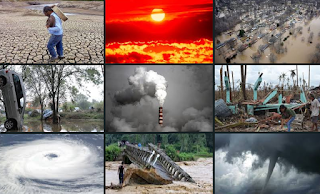"Every year has extreme stuff that goes on," says Jeff Weber, an atmospheric scientist at the University Corporation for Atmospheric Research in Boulder, Colo. "But 2015 was a highly unusual year."
As we exceed 400 ppm of atmospheric CO2, we cannot ignore the large and growing body of scientific evidence that suggests greenhouse gas emissions are contributing to a range of extreme weather events.
As quoted in the Washington Post, Al Gore says that there has been a 100-fold increase in the number of extreme, high-temperature events around the world in the distribution curve. In Gore's words, scientists are increasingly talking about a changing climate as opposed to anomalous weather incidents:
"The leading scientists have in the last two years changed the way they discuss that particular connection. It’s true that it used to be common for them to say you can’t blame any single extreme weather event on global warming. What you had to say is the odds have shifted and those events are becoming more common and extreme. They’ve now changed their description of that connection. The temperature has increased globally and there’s now 4 percent more water vapor in the Earth's atmosphere than 30 years ago. As a result, every extreme weather event now has a component of global warming in it...The fingerprint of man-made global warming is all over these storms and extreme weather events."Warmer temperatures, bigger storms and deeper droughts are part of a disturbing trend. As explained in the COP21 Weather Disaster report, "Between 1995 and 2015, EM-DAT recorded 6,457 weather-related disasters, which claimed a total of 606,000 lives and affected more than 4 billion people. On average, 205 million people were affected by such disasters each year."
The report goes on to calculate the costs of these extreme weather events. "EM-DAT recorded losses totaling US$ 1,891 billion13 from weather related disasters between 1995 and 2015, equivalent to 71% of all losses attributed to natural hazards (figure 13). This figure is a minimum given widespread under-reporting of losses around the globe."
Not only did 2015 record the hottest summer in the hottest year on record the data suggests that the warming trend is accelerating. The precede annual global heat record was set in 2014. In 2015 extreme heat waves swept across Australia and the Middle East from Egypt to Syria. In Iran it was 160 degrees Fahrenheit. Pakistan and India also suffered from deadly heat waves. The Christmas season set a number of heat records in the North Eastern part of North America. At the end of last year temperatures in the Arctic rose 60 degrees Fahrenheit above normal, pushing temperatures above the freezing point for only the second time ever in recorded history.
“The warmth means there is more fuel for these weather systems to feed upon,” Dr. Trenberth said. “This is the sort of thing we will see more as we go decades into the future.”
We have seen more than 30 consecutive years of above average temperatures. Heat records tell the story of climate change and global temperature data underscores the urgency of the need for climate action.
In 2015 there were a record number of strong hurricanes and typhoons in the Pacific basin, including the strongest hurricane every recorded. The Philippines were particularly hard hit by hurricane Lando. In the US in December there were almost 100 tornadoes reported in 15 states from California to the Carolinas, including some of the deadliest tornadoes ever in Texas. There were also irregular snow storms in Texas and New Mexico and Freezing weather in California. We have seen extreme drought in parts of Africa (southern Africa and Ethiopia in particular) and in California drought has given way to floods. There has been major rainstorms in Yemen, and historic flooding along the Mississippi River, South America (especially in Paraguay, Uruguay, Brazil and Argentina) and the UK.
As reported by the New York Times research by a group of scientists at Oxford University led by Dr. Myles R. Allen along with American and Dutch researchers, recently completed a report that indicates "extreme rainstorms in the British Isles in December had become about 40 percent more likely as a consequence of human emissions."
While El Niño has contributed to anomalous weather in 2015, it is only a part of a wider trend. Dr. Allen's research indicates that El Niño did not contribute to the extreme rainfall in the UK.
Matthew Rosencrans, head of forecast operations for the federal government’s Climate Prediction Center in College Park, Md., said that the El Niño was not the only natural factor at work.
These extreme weather events are not just expensive statistical anomalies, they are highly destructive to the earth's ecosystems and they augur disease, displacement, starvation and death.
"As scientists, it’s a little humbling that we’ve kind of been saying this for 20 years now, and it’s not until people notice daffodils coming out in December that they start to say, ‘Maybe they’re right,’" said Dr. Allen.
Here is NASA's video titled 2015: One Year of Storms, it captured extreme weather events from space. Watch the snowstorms, tropical storms, typhoons, hurricanes and floods captured by NASA in 2015.

0 comments:
Post a Comment